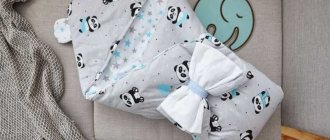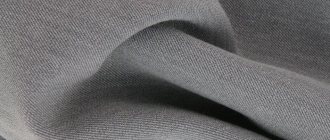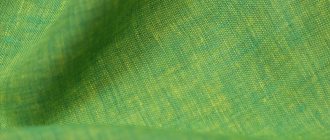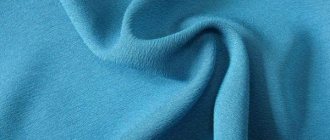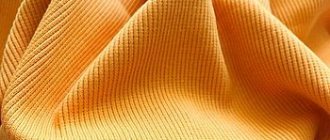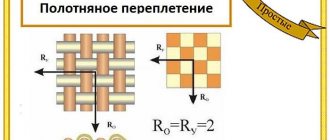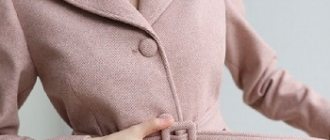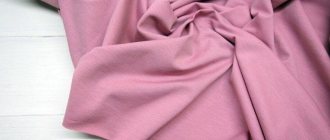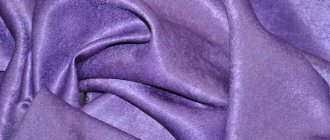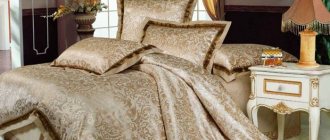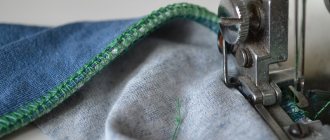A huge range of fabrics are classified according to several criteria:
- by composition;
- by weaving method;
- by appointment;
- by season;
- by finishing.
All woven materials are divided into artificial, mixed and natural based on their fiber composition.
The first are made exclusively from synthetic materials, the second combine natural and artificial raw materials, and the third are completely woven from natural fibers. Most often, natural and mixed fabrics are used for sewing clothes and household items. The group of materials made from natural fibers includes the following types:
- silk;
- cotton;
- woolen;
- cotton
The name of the materials may be the same, but the composition of the fabric may be completely different . This is because the material is often named by its weave, and the same weave is used for all types of raw materials.
Let's look at what types of fabrics are made from natural fibers.
Silk group
The names of the fabrics and their detailed characteristics can be seen in our column “From A to Z”. It is worth distinguishing between natural and artificial silk, since this group includes materials not only from pure silk, but also from mixed and completely synthetic raw materials. Moreover, the share of silk from chemical fibers is more than 90%. This is due not only to progress in the textile industry, but also to the high price of natural silk.
Characteristics of silk fabrics are usually limited to a description of appearance. The material made from silk threads is really very attractive: it shines and shimmers in the sun, light, soft and pleasant to the touch. In addition, silk has high utilitarian properties: hygroscopicity, low shrinkage, and drapes well. This is a light, elastic and durable material.
The production of silk fabric is a very labor-intensive and costly process, so the natural material has a high cost and is highly valued on the market. The raw material for producing silk threads are silkworm cocoons. First, caterpillars are raised, which after a few weeks spin cocoons. Then they are dipped in boiling water and carefully unwound. The result is a matte yellowish thread.
The following types of weaves are used to make silk:
- Satin. The material obtained by this weave, also called satin, has a matte back and a smooth front surface with shine. The disadvantage is increased friability and slipping when cutting. Various combinations of satin weave are used to produce satins and satins.
- Linen. This method allows you to adjust the density of the fabric by increasing the number of threads per inch. The more there are, the more dense the resulting matter is. Names of plain weave fabrics: crepe de chine, crepe georgette, chiffon, toile.
- Twill. The threads intersect with an asymmetric shift, so a diagonal small scar is clearly visible across the entire front surface. Used for the manufacture of lining materials, underwear and bed linen.
- Finely patterned. Derived from the main types of weave. It produces ribbed, diagonal or herringbone material.
- Large patterned. A more well-known name for large-patterned weave fabrics is jacquard. It is woven on special machines with computer programs. The result is material with relief patterns of various types.
- Combined. The combination of different types of weave allows you to improve certain qualities of the fabric.
According to the finishing and color design, silk fabrics can be boiled, gray, plain-dyed, multi-colored, bleached, printed, embossed and mulined.
According to their purpose, silk is divided into subgroups: dress, lining, furniture and decorative, technical, shirt, costume and blouse.
Pre-finishing
Initial or pre-finishing consists of preparing the material before dyeing or giving the material the properties necessary for bleached linen. But before the finishing itself, it is necessary to check the quality of the material received for work and make a culling.
Cotton material finishing
Fabrics containing cotton fibers are processed in the following ways:
- scorching - surface treatment using a gas burner or molten metal in a trench; protruding ends and excess fibers are removed (material that is then subject to napping, for example, flannel, is not processed in this way); the surface becomes cleaner and smoother;
- desizing - removal of a reinforcing composition from the surface of the threads (sizing); gives softness and the ability to better absorb water;
- boiling - soaking in alkali to wash out organic matter; the process softens the fabric, but gives the canvas a gray-brown color;
- bleaching - removal of natural pigment from fibers by treatment with sodium hydrochloride;
- mercerization - special treatment of fabric with alkali to make it smooth and silky (for example, for satin fabrics);
- napping - passing the fabric through a special napping machine to obtain fleece on the surface (for flannel, flannel).
You might be interested in How to work correctly with contours Decals for fabrics
Mercerization
Linen finishing
Preparation for subsequent dyeing of linen fabrics is carried out on the basis of a scheme corresponding to cotton ones, but with some deviations. The flax material goes through the following stages:
- How to bleach laundry at home?
- scorching;
- desizing;
- boiling - repeated 2-3 times, each subsequent time using a weaker alkali solution;
- acidification - treatment with a sulfuric acid solution to enhance the bleaching effect and remove impurities;
- bleaching - is carried out in four stages, alternating with the processes of boiling and acidification for complete or partial bleaching; According to the degree of bleaching, linen fabrics are produced as ¼ white, semi-white, ¾ white and completely white.
Bleaching and drying
Finishing of wool fabric
Woolen materials are divided into two types: worsted and cloth. Worsted fabric is thin, light, and a clear pattern of interlacing threads is visible on the front side. Cloth - thicker, maybe with pile. Actual differences dictate specific pre-finishing approaches.
Worsted fabric finishing
Includes the following steps:
- scorching;
- washing - removing animal fat and other contaminants;
- carbonization - used for 100% wool materials; consists of treatment with a solution of sulfuric acid with drying and further heating; foreign impurities are completely destroyed, while the wool fibers remain unharmed;
- brewing - alternate treatment with boiling and cold water to relieve stress in the fibers and impart shrinkage;
- wet decatification - treatment with water and steam on decatification machines for compaction.
Cloth finishing
Includes the following steps:
- washing;
- carbonization;
- brewing;
- wet decatification;
- rolling - is carried out to impart density and form a felt flooring on the surface;
- napping;
- ratification - laying the pile in a given direction.
Pile material
Natural silk fabric finishing
Silk fabrics undergo fewer processing steps, namely:
- boiling - treatment in soapy water at 95°C for 2 hours to remove pigment and fatty substances; during processing the material becomes soft;
- bleaching - using hydrogen peroxide, the material is bleached so that it becomes completely white.
Bleached silk
Chemical fiber fabric finishing
They are processed similarly to fabrics made from natural silk, but the process is completed with a stabilization stage - exposure to steam on the stretched fabric; this method removes internal stress in the fibers and forms the structure of the material for its further use.
You might be interested in what is special about Vologda lace: the origin of the lace, simple patterns
Bleached viscose
Cotton group
The history of cotton fabric goes back thousands of years. During this time, the range of fabrics expanded to 1000 items. The material has received enormous popularity for the following properties:
- hygroscopicity;
- low cost;
- wear resistance;
- softness;
- environmental friendliness.
The disadvantages of cotton are a high degree of creasing and shrinkage. To remove these disadvantages, the raw materials for the material are finished or combined with other fibers, including synthetic ones.
Fabric production begins with the collection of cotton bolls. Cotton fibers are then extracted from them, which will become the basis for threads. The longer the fibers, the better the quality of the material. Cotton raw materials are cleaned and sorted. They are then made into threads. The density of the fabric depends on the thickness and method of twisting the threads.
Cotton threads are sized to prevent tearing and increase strength. The spinning mill produces the fabric itself. Most types that make up the range of cotton fabrics are woven using plain weave and its derivatives. Jacquard, finely patterned and other types of weaves are also used. The fabric is initially white due to bleaching. After cleaning the glue, the material is painted or a pattern is applied, if you want to get a fabric with a print. The cotton can then be further processed.
According to its purpose, cotton fabric is divided into household and technical. There are 17 groups of cotton materials: linen, clothing, towel, shawl, lining, teak, dress, furniture and decorative, pile, blanket, gray fabrics, calico, calico, satin, gauze, packaging and technical fabrics.
Chintz is made using plain weave. This is a plain-dyed material or fabric with a pattern obtained by printing.
Calico is a denser and coarser fabric due to the use of thicker threads . Produced in plain weave. This type is heavily sized to improve resistance to wrinkles and shrinkage.
Satins are woven with satin or satin weave. The front surface is smooth. These types of fabric are often mercerized. This is a chemical treatment of threads that makes them silkier, softer and shiny.
The most understandable is the classification of cotton fabrics according to seasonality. This is especially true for the dress group. It includes the following types:
- Demi-season. Fabric production is carried out using plain, twill and finely patterned weaves. Demi-season materials are characterized by greater fabric weight, reinforced structure, thickness and strength. The name of the fabrics of this subgroup often coincides with the names of woolen fabrics. Demi-season items include tartan, crepe, taffeta, poplin, garus, wool, pique and others.
- Summer. Most often it is a lightweight fabric of light colors. Weaves used: plain, jacquard, combined. The range of summer fabrics includes: voile, cambric, voile, percale and many others.
- Winter. This is usually a fabric with a pile or rib. The brushed surface and increased density of the fabric are obtained through the use of backcombed weft threads. This subgroup includes the following names: flannel, flannel, fleece.
Both thick and thin fabric can be made from cotton thread. A variety of weaves and the use of threads of different thicknesses allow you to obtain the most delicate veil and warm flannel. The names of the fabrics often coincide with the names of materials made from silk, wool or linen.
Fabric finishing
Category: Clothing
Fabric finishing refers to a complex of chemical and physical-chemical effects on fabric to improve its consumer properties. Fabric finishing consists of the following stages: preliminary finishing, color finishing (dyeing, printing), final finishing, special finishing.
Different fabrics based on raw material composition have their own characteristics in finishing.
Pre-finishing
Cotton fabrics are subjected to singeing, boiling, bleaching, and mercerization. Linen fabrics are boiled, sour, and bleached.
The finishing of woolen fabrics differs significantly from the finishing of cotton and linen, which is explained by the peculiarities of the structure and properties of wool fiber. Woolen fabrics are singed, felled, and decated (the fabric is treated with steam, hot and cold water).
Carbonization is carried out only for pure wool fabrics to remove remaining plant impurities.
Natural silk fabrics are bleached and revived (the fabric is treated with a weak solution of organic acid). Some suit and dress fabrics are made with pile weight, which contributes to better drape.
Fabrics made from chemical threads are boiled to remove oils and adhesives. To relieve internal stress and prevent creases, synthetic fabrics are stabilized by exposing the straightened and stretched fabric to steam or hot air.
Fabric dyeing
When dyeing, the fabric is dyed through and evenly. Such fabrics are called plain-dyed. Plainly dyed fabric can be obtained by using fibers or threads dyed in the mass, then the fabric has a uniform color not only over the surface, but also over the thickness.
Fabric printing
Printing, or patterned coloring of fabrics, is the process of applying and fixing dye to certain areas of the material.
Printing is carried out in various ways: machine, mesh, template, airbrush, transfer printing (sub-static).
Based on the method of applying the design, printing is divided into direct, etching and backup.
In direct printing, a design is applied to fabric that has been bleached or pre-dyed in light colors. In the latter case, direct printing is called background printing.
Depending on the area occupied by the design, printed designs are distinguished as white-ground (up to 40% of the fabric area), semi-ground (40-60%) and ground (more than 60). To obtain an etched print, the fabric is first dyed smooth, and then an etching composition is applied by printing, which discolors the fabric in these places. The result is a white pattern on a dark background. But you can also get a color drawing. To do this, a dye that is resistant to it is introduced into the etching composition.
Reserve printing is obtained by applying a protective (reserve) composition to undyed fabric. Then the fabric is smoothly dyed, and in places where the reserve composition is applied it is not dyed.
Final finishing of fabrics
Fabrics after preliminary finishing, dyeing and printing do not have a marketable appearance. For the final external design of fabrics and improvement of their aesthetic properties, final
finishing.
Main types of final finishes:
finishing
- applying a sizing agent to the fabric, which includes adhesives (starch, dextrin, etc.) to give the fabric fullness and rigidity. Depending on the amount of sizing agent applied, fabrics with a soft muslin (1-3% sizing agent), medium (5-6%) and hard (up to 10%) finish are obtained;
expansion
produced on a drying-stitching machine using moistened fabric to straighten it and obtain a standard width;
calendering
- passing the fabric through a hot calender. After this, the fabric becomes smooth, soft and pleasant to the touch.
Other types of final finishing are also used.
Special fabric finishing
Special types of finishing are produced to reduce or eliminate deficiencies in fabrics, to impart important properties to them (water resistance, low wrinkleability) or to create any effects that improve aesthetic properties.
Special types of finishes: anti-crease, water-repellent, antistatic, anti-moth, durable embossing, durable gloss, corrugation, metallization, etc.
The final stage in the formation of consumer properties of fabrics is finishing. Finishing operations can improve the appearance of fabrics and give them additional properties that increase their competitiveness. The finishing operations procedure is determined by the raw material composition, the type of threads and the purpose of the fabrics. There are preliminary, coloristic, final and special finishing of fabrics.
Main pre-finishing
cotton fabrics are:
- scorching
- removal of protruding ends of fibers from the surface of rough fabric, with the exception of fabrics with fleece (fleece, flannel, cotton wool), pile and gauze;
- desizing
- removal of the size applied to the warp threads before weaving to strengthen it, as well as pectin and nitrogenous substances;
- boiling
in an alkaline solution to remove impurities, impart softness, plasticity and increase the wettability of fabrics;
Large weaving patterns of a geometric, plant or animal nature are formed on the front surface. There are simple jacquard weaves using two thread systems and complex ones using three or more thread systems. They produce dress, suit, coat, furniture and decorative fabrics, scarves, blankets and bedspreads.
- whitening
produced to destroy the natural color of fibers in two ways: chemically using sodium hypochloride, hydrogen peroxide and other substances; optical - by applying a fluorescent dye;
- mercerization
- treatment of fabric with an alkali solution at a low temperature in a tense state to impart softness, silkiness, increase strength and hygroscopicity. Local application of an alkali solution to the fabric in a relaxed state allows you to obtain the effect of crinkling and corrugation;
- napping
- the formation of a fleece coating on the surface of the fabric to increase its heat protection and softness.
Pre-finishing of linen fabrics includes: singeing; desizing; boiling
in a solution of alkali and soda to make fabrics soft and wet (dark gray boiled fabrics);
acidification
with a weak solution of sulfuric acid to remove impurities and partial bleaching (acidified fabrics of light gray color);
bleaching with hypochloride
Complete whitening is carried out in four stages. Based on the degree of whiteness, there are 1/4, 1/2, 3/4 white and white fabrics.
Wool fabrics are subjected to:
- scorching
(only worsted fabrics to reveal the weaving pattern);
- tea leaves
boiling water to improve mechanical properties and give tissue uniformity;
- flushing
detergents to remove contaminants;
- Valke with
the purpose of forming a felt-like covering, increasing the density and heat protection of cloth fabrics.
There are: strong
roll for draperies and cloth (3.5-8 hours),
moderate for - carbonization (pure wool fabrics) with a weak solution of sulfuric acid to remove plant impurities;
- napping,
as a result, a backcombed pile is formed on the surface of cloth fabrics, and the fabrics become softer, fluffy and heat-protective;
- ratification,
during which the pile on the front surface of the fabric is laid in the form of various shapes;
- whitening
chemical and optical methods, but very rarely, since this reduces the strength of the tissues;
- wet decatification
hot water and steam to equalize stress and prevent the formation of creases in combed and fine-woven fabrics.
Silk fabrics in the pre-finishing process: singe
(fabrics made from yarn);
boiled
in soapy water to impart softness, elasticity and a delicate shine;
revived
with weak solutions of organic acids, which gives the tissues a characteristic touch, crunch and squeak;
bleach,
but rarely;
they weigh down
(some fabrics) with mineral or organic compounds, synthetic salts, which increases density and improves drapability, but reduces strength and increases the fragility and fragility of fabrics.
Fabrics made from chemical threads are lightly boiled in a soap-soda solution to remove various impurities and contaminants. For fabrics made from synthetic fibers, thermal stabilization is carried out with hot air or steam in a straightened state in order to relieve internal stress and improve a number of properties.
Color finishing
fabrics involve dyeing and patterned coloring.
Dyeing is carried out with a variety of dyes. Fabrics dyed the same color over the entire surface are called plain-dyed.
Printing (printing) of fabrics is the application of a colorful single or multi-color pattern to fabric. There are the following methods of drawing: manual and machine. Hand printing is used to obtain highly artistic designs only on piece textiles (tablecloths, headscarves, scarves, etc.). Machine printing has the following varieties:
- direct printing - the design is applied from the front side to pre-bleached or light-dyed fabric. Depending on the area occupied by the design, direct printing can be white-ground (the design occupies 30-40% of the fabric area), covered (40-60%) and ground (more than 60%);
- watercolor printing is done on moistened fabrics on one side (one-sided printing) or on both sides (double-sided printing);
- etching printing - an etching composition is applied to a plain-dyed fabric in accordance with the design, destroying the color to white in the places of application. Then a color design is printed on the etched areas. Etched designs are distinguished by clear contours;
- Backup printing is more complex than etching and is used in cases where the background color of the fabric cannot be etched efficiently. To do this, a reserve (protective composition) is applied to the undyed fabric using a printing roller and then the fabric is dyed. After removing the reserve composition, white areas of the fabric are visible, on which a color pattern can be printed;
- airbrush printing allows you to obtain highly artistic, colorful designs. Using a stencil and an airbrush, dye is applied to the fabric by spraying from different distances, which affects the intensity of the color;
- sublistatic (thermal printing) - transfer of a pattern from a paper substrate to fabric during short-term thermal contact. The pattern has clear contours and can be of different sizes and colors.
Final finishing
fabrics are produced to improve their appearance, quality and consumer properties. The procedure depends on the raw material composition and purpose of the fabric. The main stages of final finishing of cotton fabrics are:
- alcohol lamp - bleaching undyed areas of fabric;
- widening - leveling the width of the fabric to a given standard, eliminating weft distortions;
- finishing - applying finishing agents (chemical solutions) to the fabric, giving the fabrics rigidity, fullness, shine, wrinkle resistance, smoothness, resistance to dirt, abrasion, light and water;
- calendering - passing fabric between heated calenders (rolls) to smooth, compact and impart an external effect of embossing, silkiness, dullness, etc. Fabrics with a relief, pile and crepe surface are not calendered or finished;
- tufting - raising on tufting machines the pile pressed during finishing operations.
For linen fabrics, finishing, drying, moistening and spreading are carried out. Silk fabrics are subjected to widening, finishing, raising and leveling the pile of plush and velvet, obtaining an etched shaped pile pattern using a thick solution of sulfuric acid; they give a crepe effect by boiling or using crepe threads (strong twist), obtain a corrugated effect (small folds) and a cloque effect (relief pattern) by using threads with varying degrees of shrinkage or treating sections of fabric with substances that increase shrinkage.
The final finishing of woolen fabrics includes drying, widening, cutting the ends of the fibers from the front surface of the fabric, pressing to compact and give elasticity and smoothness to the fabric; Decatting - steam treatment of fabrics to reduce shrinkage, rattinting, i.e. obtaining figured patterns in the form of peas, knots, etc. on pile fabrics.
Special finishes
fabrication is carried out to give fabrics new, special properties and eliminate existing deficiencies: water-repellent, antistatic, dirt-repellent, etc.
Watercolor
- a type of printing in which a design is printed on dampened fabric, as a result of which it resembles a watercolor. With significant moisture, a pattern with blurred edges is obtained.
Antistatic Finish (AO)
- treatment of fabrics made of synthetic fibers with surfactants that reduce surface electrical resistance (alkamon OS-2, epamin-06, tetramon C).
Finishing
- applying finishing agents, which include starch, glue and other substances, to the fabric to give it rigidity, wrinkle resistance, shine and gloss, and better washability.
Airbrush printing
- a method of applying highly artistic drawings with a gradual transition of colors from dark to light tones and the overlay of different colors. The design is applied using stencils with cut-out patterns by spraying with an airbrush.
White earth seal
— the color pattern is applied to the white background of the fabric and occupies a small area on the surface (up to 30-40%).
Velours
- finishing of woolen cloth fabrics by obtaining a pile surface with raised pile.
Waterproof finish
- continuous covering of the reverse side of raincoat and tent fabrics with films made of a rubber mixture or based on synthetic resins.
Water repellent finish
- coating of raincoat and umbrella fabrics with hydrophobic emulsions (silicones, chromolan, etc.), resulting in improved water-repellent properties while maintaining vapor and air permeability.
Napping
- the formation on one or both sides of the fabric with the help of a napping machine of a fluffy, soft cover (bouffant), consisting of the ends of fibers drawn from threads, mainly weft, from carded low-twisted or hardware yarn.
Etch print
- obtaining a pattern on a colored background by applying thickened chemically active compounds (etchants) to plain-dyed fabrics, which destroy the dye in the printed areas and discolor the original color. It is possible to subsequently paint the discolored areas with a different color.
Corrugated
- obtaining convexity by local treatment with a solution that causes shrinkage of individual sections of fabrics (nylon - with phenol, cotton - with alkali).
Ground printing
— the pattern occupies the main part of the fabric surface (more than 60%).
Dirt-resistant finish
- treatment of clothing, decorative, upholstery, and special-purpose fabrics with preparations that are both water-resistant and oil-resistant (organofluorine compounds).
Hard finish
- imparting rigidity to calico by finishing with a concentrated solution of starch, subsequent drying and calendering.
Calendering
- final finishing, performed with the aim of smoothing, compacting the fabric, giving it smoothness and a glossy shine. All fabrics are subjected to calendering (passing fabric between a system of heated steel rollers) with the exception of fabrics made from twisted and shaped yarn, with a relief surface, piled, and with a soft finish.
Carbonization
- the operation of cleaning pure wool fabrics from cellulose impurities using a solution of mineral acid, during which the wool fiber is not damaged, but the cellulose is destroyed. To remove acid residues and destroyed cellulose particles, the fabric is neutralized with a weak soda solution and washed.
Castor
— finishing of drapes by obtaining low-cut, smoothed and pressed pile (drape castor).
Acid fabrics
- linen fabrics treated during the finishing process with a solution of sulfuric acid, which helps remove impurities, causing the fabrics to become softer and acquire a light gray color.
Dyeing
- a physical and chemical process of interaction of fibers and threads of fabric with dye, as a result of which it acquires a uniform color that is resistant to various external influences. Fabrics that have gone through the dyeing process are called plain-dyed.
Lake
— obtaining shine as a result of melting the surface of the fabric when processed with a hot friction calender. Used for silk fabrics made of thermoplastic fibers (acetate, polyamide, polyester).
Dell or glossy finish
- adding shine by applying a sizing agent with a high concentration of starch and substances that promote shine (profin, wax, stearin), and then drying the treated fabric with a hot, smooth calender. It is used for plain weave cotton fabrics and for piece goods (tablecloths).
Low-crease (MC) and low-shrink finishes
— impregnation of cotton, linen, viscose fabrics with pre-condensate (thermosetting resins - corbamol, metazin, etc.) followed by heat treatment, washing and drying. Disadvantage: loss of strength by 20-40%.
Machine printing
- the most common method of patterned coloring of fabrics, which is carried out on fabric printing machines.
Melange finish
- formed by using threads (yarn) made from a mixture of differently colored or dyed and undyed fibers.
Mercerization
- treatment of fabric with an alkali solution in a stretched state to give the fabric softness, smoothness, shine, and increase hygroscopicity. In a relaxed state, when an alkali solution is applied topically to the fabric and dried, the effect of compression and corrugation is obtained in the form of wrinkles and swellings formed as a result of shrinkage.
Metallization
- applying a metallized layer to decorative fabrics for special purposes (technical, etc.) by spraying or deposition in a vacuum of metallic paint (pigment - particles of silver, brass, aluminum, etc.).
Muslin trim
- imparting softness to cotton dress fabrics by finishing with a weak solution of adhesive or softening substances (soap, esters of higher fatty acids - alizarin oil, alkamon OS-2, steoroz-6, etc.) and subsequent drying.
Printed finish
- created by applying a color pattern to the front surface of the fabric using printing machines. It is characterized by a difference in the tone of the pattern on the front and back surfaces.
singeing
- removal of protruding fiber ends from the surface of the fabric. For singeing, gas (for light fabrics) and plate (for dense, heavy fabrics) singeing machines are used.
Optical whitening
— consists of treating fabrics with optical brightening agents (OBS) that have the ability to fluoresce. UVB absorb ultraviolet rays and convert them when emitted into blue rays, which, when reflected from the surface of the fabric, give it whiteness.
Whitening
- giving fabrics a stable whiteness, necessary for the production of linen (white), printed and dyed fabrics in light colors. There are chemical and optical whitening.
Multi-colored finish
- is formed during the weaving process, when threads (yarn) of various colors are used to produce warp and weft fabric. The main patterns are stripes, checkers, checkerboard patterns, herringbone.
Semi-ground printing
- the pattern occupies a slightly larger area on the surface of the fabric (40-60%).
Anti-rot treatment
- imparting antiseptic properties to cotton and linen fabrics by treating them with special substances (salts of chromium, copper, mercury, lead, copper compounds, organic compounds - derivatives of phenol, salicylic acid, sulfur).
Raster printing
- the drawing consists of a system of dots or dashed stripes of different sizes. The engraving of the printing roller in this case is represented by dotted or dashed depressions, the size, depth and frequency arrangement of which determine the intensity of coloring of the fabric.
De-sizing fabric
- removing from the fabric the size applied to the warp threads during the weaving process, since the size makes finishing difficult. It is removed with the help of acids, alkalis, oxidizing agents and various enzymes of animal and plant origin, under the action of which the size is hydrated, becomes soluble and is removed by washing with water.
Backup Print
- a method in which a protective composition (reserve) in the form of a pattern is applied to bleached fabric using a printing roller, after which the fabric is smoothly dyed. In areas of the fabric protected from dyeing by the reserve, a white pattern is formed. When applied together with a reserve composition of a dye that is resistant to it, a reserve seal is obtained.
SKET
- the first letters of the words: resin, catalyst, electric calender, heat treatment - obtaining a pattern on printed calico with an indelible shine by adding pre-condensate (carbamol) to the printing ink, followed by passing through the calender and heat treatment, as a result of which the pattern becomes shiny and bright, and the fabric - less crushable. “SCAT.”
Silver-silky (SSH)
- imparting shine and silkiness to satin. It differs from permanent embossing by the use of a solution with a lower content of adhesives and a silver calender engraved with frequent strokes, as a result of passing through which the optical effect of a beautiful shine is created.
“Wash and wear”
- a type of anti-crease finishing of fabric for clothing purposes. It consists of impregnation with a solution of precondensates based on carbamol and methazine. After washing the fabric with low mechanical stress, you do not need to iron it.
Permanent embossing (ST)
- obtaining a relief pattern using an embossing calender (a metal shaft with a convex engraving) on fabric pre-impregnated with a solution of pre-condensate (carbamol, methazine, glycosine). Disadvantage: loss of fabric strength when wet by 20-40%.
Sublistatic
- a method of thermal printing, which involves transferring a pattern from paper to fabric during short-term thermal contact. They get patterned colors in a wide range of colors, with patterns of different sizes and clear contours.
Heat setting
- treatment of fabric made of synthetic fibers (or containing synthetic fibers) with hot air or steam. The operation takes place for a short time in a straightened state. Necessary for relieving internal stresses and local structural changes in the fiber that occur during processing.
Lasting shine
- imparting increased shine to cotton dress fabrics. The finish is similar to permanent embossing, but is applied using a smooth calender.
Bottle, ratin
— finishing of draperies by obtaining figuratively arranged pile in the form of a herringbone, stripes, balls (drape-flacote, drape-ratin).
Flocking
- finishing of fabric by applying short fibers to it by mechanical, airbrush or electrostatic methods. The pile on the surface is fixed with synthetic resins.
Background printing
- the design is applied to pre-dyed, usually light-colored, fabric.
Fornis
- finishing to fix the shape and make the garment made from cellulose fabrics crease-resistant during heat treatment. The fabric for the product is pre-impregnated with a solution of pre-condensates, dried and wrapped in plastic film.
Photofilmprinting
- a method of applying a pattern to fabrics made of natural silk, chemical fibers or containing them, which have a movable structure and can form distortions when stretched. The design is applied using mesh templates (a rectangular frame with a stretched nylon mesh) that have areas not covered with polymer. Printing ink is poured into the template and rubbed through the mesh with a roller. The paint transfers to the fabric only in open areas, creating a pattern on the fabric.
Foulard finish
- imparting softness and shine to cotton, dress and decorative fabrics by finishing with a solution of low concentration adhesives (starch, dextrin, glue), followed by drying and passing through a hot calender.
Chemical bleaching
— destruction of natural fabric dyes by their oxidation with sodium hypochlorite, hydrogen peroxide, sodium chlorite and other oxidizing agents.
Widening
— leveling the width of the fabric by straightening the weft threads after finishing.
Fabrics after weaving are called severe (severity). In order to increase the service life, improve the hygienic and aesthetic properties of fabrics, they are subjected to finishing.
Fabric finishing is understood as a complex of chemical and physical-mechanical processes aimed at improving the appearance and giving fabrics properties that meet their purpose.
Thus, in the process of chemical treatment, various natural substances and impurities are removed from fabrics, as well as substances introduced during the production of yarn and fabrics (starch, glue, glycerin, fats, sericin, etc.). As a result of these operations, the fabrics are given a certain whiteness, shine, and color; a number of fabric properties are improved (hygroscopicity, wrinkle resistance, softness, drapability, strength, etc.).
In the process of physical and mechanical processing of fabrics, they acquire increased heat protection, strength, good appearance, softness, etc. For this purpose, fabrics are subjected to felling, shearing, napping, ironing, decating, etc.
Wool group
The range of this group includes fabrics made from animal wool. Materials containing 100% natural raw materials are considered pure wool, but additions of other fibers and threads are allowed no more than 5%. Fabric production is carried out from sheep, goat and camel wool.
The main property of wool fabrics is the ability to retain heat. The disadvantages are increased dust holding capacity, accumulation of static electricity, difficulties in cutting and sewing products, and high maintenance requirements.
The main classification of wool fabrics is carried out according to the type of yarn used and the manufacturing method. Wool materials are divided into the following main types:
- Worsted. Made from combed yarn. The weave pattern is open. This is a fairly thin fabric made using plain, twill, crepe, and jacquard weaves. The worsted group is divided into three subgroups: dress (crepes), suit (cheviots, tights, bostons, crepes) and coats (gabardines, cover coats).
- Fine cloth. The fabric is produced from machine-made fine yarn. This is a fabric with a pile that covers the weave pattern. Plain, twill, finely patterned and multi-layer weaves are used. This subgroup includes dress, suit and coat fabrics (drapes, cloth). Popularly, thin-woven materials are called ribbed fabric. The density of the fabric makes draping and cutting difficult.
- Rough cloth. Made from thick hardware yarn. Most often it is loose, dense and rough fabric. Used for sewing workwear.
Types of additional fabric processing - description
Often, the description of the fabric from which textile accessories are made indicates the type of additional processing. This article will examine the main types of additional processing of fabrics currently used in the manufacture of canvases.
The main types include:
1. Sanforization
Technology of anti-shrink finishing of cotton or other fabric, which, in essence, is the process of pre-shrinking the fabric. Bed linen made from fabric with such pre-treatment does not shrink after washing.
2. Finishing
Impregnation of fabric with a special composition based on starch, synthetic resin, and dextrin. After this treatment, fabrics become stiffer, denser, and wrinkle more easily.
3. Decatation
Treatment of woolen fabrics with hot water or steam. Allows you to avoid shrinkage of fabrics during further use.
4. Carbonation
Treatment of woolen fabrics with a weak solution of sulfuric acid to remove plant impurities.
5. Mercerization
Treatment of cotton fabrics with concentrated alkalis in a stretched state. The finishing process imparts greater strength, shine and silkiness.
6. Livening
Passing silk fabrics through an acid bath to give the fabric a more noble appearance and improve color intensity and shade.
7. Whitening
Treatment with bleaching solutions to remove the natural color of fabric fibers, render them white, and prepare for subsequent dyeing.
8. Printing
Applying a colorful design, which may consist of one or several different colors. Obtaining various patterns on fabric. The printing process is sometimes called printing, and fabrics processed by this method are called printed or printed fabrics.
9. Fireproof fabric impregnation
Surface fire protection of fabrics, based on the formation of poorly soluble compounds on the product. The fire hazard of fabrics is reduced by using surface or volumetric treatment of the fabric with flame retardants - fire retardants based on inhibitors.
10. Oil-water-repellent finish
Reduces the ability of fibrous materials to absorb dirt in the form of liquid oils, as well as in the form of aqueous solutions of suspensions and emulsions of various substances.
11. Anti-static finish
It is used for fabrics made of polyester fibers that are capable of accumulating static electricity charges on their surface. The fabric is soaked in a solution of an antistatic agent, wrung out and dried.
In addition, in separate articles you can learn about:
- main types of fabrics - differences;
- how often should you wash your bed linen?
- table of bed linen sizes.
Choose bed linen
Linen subgroup
Linen fabrics have high strength, hygroscopicity, thermal conductivity and wear resistance. Disadvantages: wrinkleability and difficulty in finishing. Flax is used to make bed and table linen and summer clothing.
According to its purpose, flax is divided into household and technical fabrics. Technical include materials for the manufacture of bags, packaging, canvases and covers. Household materials are divided into the following types:
- Dress and suit. They are made mainly from semi-linen. They are produced in plain, finely patterned or combined weaves.
- Linen. Used for the manufacture of underwear, bed and table linen. The main types of weaves are jacquard, plain and combined.
- Furniture and decorative. Curtain and furniture fabrics of complex weaves. In most cases, it is dense material with a textured surface (geometric, fantasy patterns or ribbed).
- Towels. These include jacquard, waffle, terry and satin towels.
- Special. Dense plain weave fabric, additionally reinforced at the base.
The name of linen fabrics often echoes cotton and silk materials. The assortment includes cambric, teak, calico, tapestry, matting, fine linen and others.

